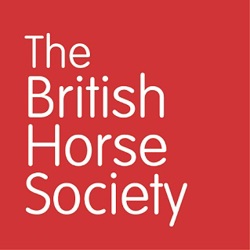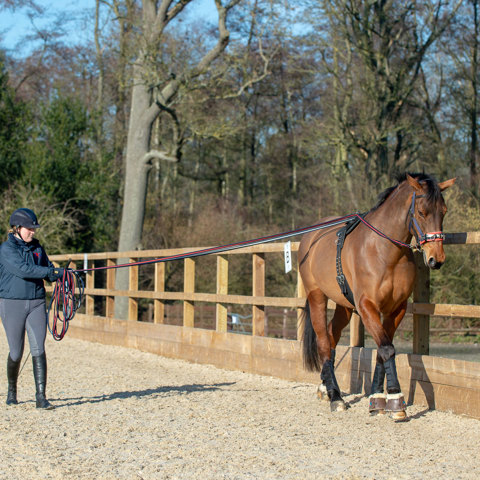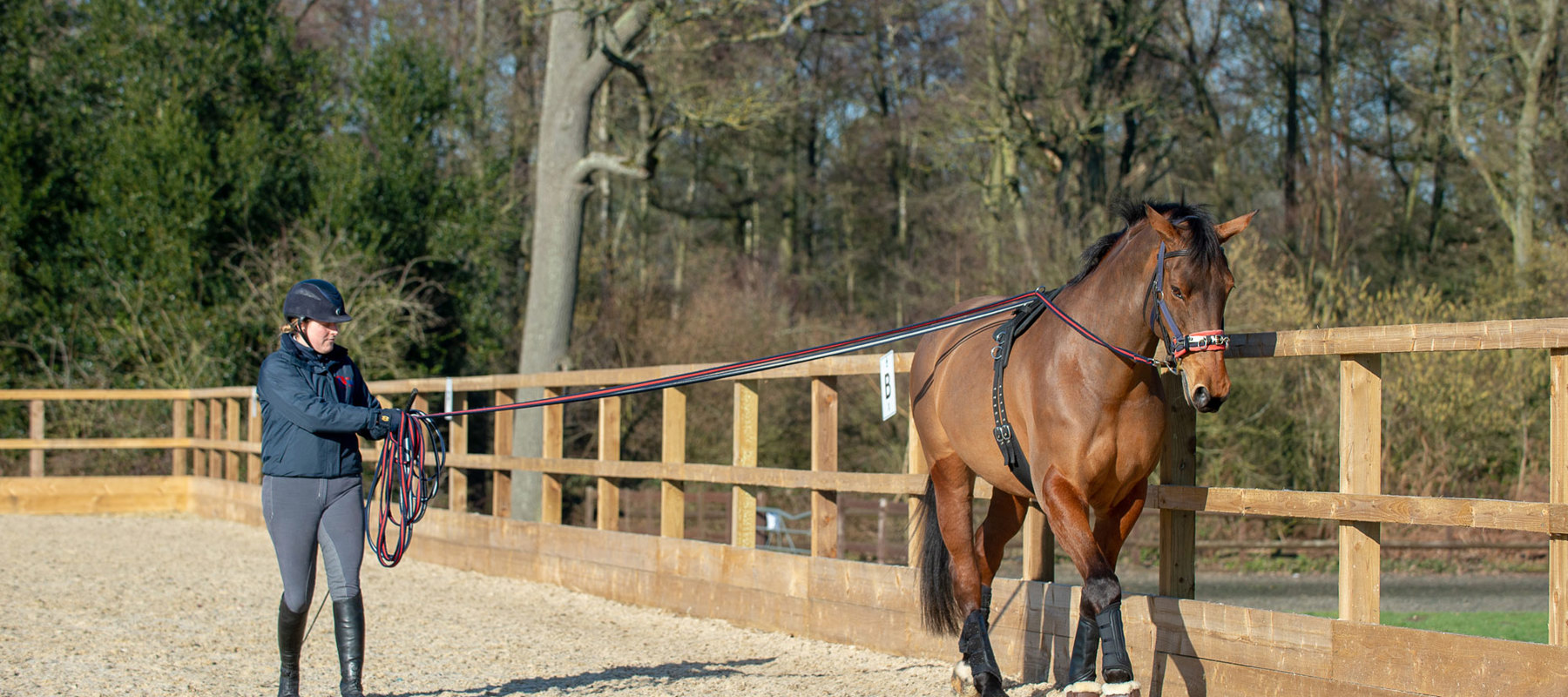Within this section you will be assessed in the following areas:
Download the assessment criteria.
1. Working the horse from the ground
chevron-down
chevron-up
Lungeing or long reining using two reins is an essential exercise to train and develop a horse’s way of going. As a groom, rider or trainer you will be expected to carry out non ridden exercise and training. This assessment demonstrates your advancing skills in lungeing with one rein to two, and long reining horses.
You will be given one horse to assess and work from the ground to develop its way of going. The horse may be of any size, type, sex or age from three years upwards. The horse may be of any level of training and experience. The horse may be capable of varying quality of work and may be any level of fitness.
The horse will be tacked up with any equipment ready for lungeing with two reins and long reining. You should check equipment for comfort and safety before you begin your session.
You should warm up the horse to assess its way of going. From your assessment you should continue to work the horse using appropriate techniques and exercises to develop its way of going and aid improvement. You should be prepared to use a combination of lungeing with two reins and long reining, unless you feel that one technique is unsuitable for the horse. You will work the horse with empathy and authority whilst developing an effective rapport with the horse.
You will be expected to use ground poles (if appropriate) to develop the way of going. An assistant will be available to help, following your instructions.
You will discuss your session with the assessor highlighting the strengths and limitations in the horse’s performance, your evaluation of the exercises and techniques chosen, your performance, and how you would plan to develop this horse’s training with future sessions. You will also evaluate the general training of horses and the process of working horses from the ground using two reins.
The assessment will last approximately 30 minutes, including discussions with the assessor and is assessed as a standalone assessment.
2. Riding and training theory
chevron-down
chevron-up
This assessment will give you the opportunity to discuss your training philosophies, methods and experience training horses for dressage up to advanced medium.
You will also analyse your experience of training a horse. You should have trained the horse for a minimum period of six months, so you have a suitable time frame to discuss any improvement seen and draw down from your experiences with this horse. The horse you choose to discuss can be of any age, type, level of training, for example; a young horse for backing, a riding school horse used for training others, a competition horse (any level) or retraining a horse for a different discipline.
In order to aid your discussion and support your analysis, you can complete an optional logbook of training (logbook template can be requested from the BHS Education team or downloaded from the website) to bring to your assessment.
You can also bring photos or videos (on your own device) as evidence to support your discussion.
The assessment should last approximately 15 minutes.
3. Assess a horse
chevron-down
chevron-up
You will assess a horse as if for personal or centre purchase. Firstly, with a static and dynamic assessment of conformation and then a ridden assessment over all three paces, on the flat.
The assessment will take place outdoors on grass and you may share the area with up to three other candidates.
The horse may be of any size, type, sex or age from four years upwards. The horse may be of any level of training and experience and may be capable of varying quality of work. The horse may be of any level of fitness. The horse will be presented to you ready to ride either in schooling or competition tack. The horse may be shod, unshod, studded or not studded.
Following your ridden assessment, you will discuss your evaluation with the assessor.
The assessment should last approximately 45 minutes, including discussions with the assessor.
4. Show jumping session – up to 1.20m
chevron-down
chevron-up
You will ride one horse during this assessment. The horse will be capable of jumping up to 1.20m and may be a competition or school horse of any type, size, sex or age.
The horse may be of any level of fitness and may be capable of varying quality of work. The horse will be presented to you ready to ride either in schooling or competition tack.
You will ride in an enclosed area and may share the area with one other candidate.
There will be a pre-prepared jumping area. The fences will not be numbered but will allow for linking of two or more fences. The fences will be a mixture of uprights, spreads, oxers and combinations. An assistant will be available to alter fence sizes as requested. You will be expected to assess the fences available before your assessment begins, although this time is not factored into the timetable of the day, so please ensure you arrive in time to do this before your assessment briefing.
You should warm up your horse and assess its abilities over all three paces and over warm up fences. You will then plan your session and utilise exercises and the fences available to develop the horse. You will be expected to ride the horse within its capabilities jumping appropriate fences and heights. You should understand competition rules and technical requirements in order to jump a 1.20m course.
You will evaluate the session with your assessor and plan the horse’s training for further development.
Throughout your discussion you should relate the horse’s way of going to the Training Scale and show a clear understanding of the show jumping requirements for British Eventing, British Showjumping and FEI competitions.
The assessment should last approximately 30 minutes, including discussions with the assessor.
5. Flat session over poles
chevron-down
chevron-up
You will ride one horse during this assessment. The horse may be a competition or school horse of any type, size, sex or age from four years upwards. The horse will be presented to you ready to ride either in schooling or competition tack (general purpose or jump saddle).
You will ride on a surface and may share the area with one other candidate. There will be an assistant available to place poles as per your instructions. You will be able to use the poles for floor patters or raised poles with blocks. You can use up to 12 poles.
You will warm up the horse and evaluate the horse’s way of going. From your evaluation you should continue to work the horse, using exercises appropriately to develop the horse’s athletic performance. The exercises you choose should have a positive effect on the horse’s way of going and performance.
You will evaluate the session with your assessor and plan the horse’s training for further development.
The assessment should last approxiately 30 minutes, including discussions with the assessor.
6. Show jumping session – up to 1.25m
chevron-down
chevron-up
You will ride two horses during this assessment. One, or both horses will be working towards jumping over fences up to 1.25m and may be a competition or school horse of any type, size, sex or age from four years upwards. The horses may be of any level of training, experience and fitness and may be capable of varying quality of work.
You will ride on a surface and may share the area with one other candidate.
The guidance below relates to each horse.
The horse will be presented to you ready to ride either in schooling or competition tack. There will be a pre-prepared jumping area. The fences will not be numbered but will allow for linking of two or more fences. The fences will be a mixture of uprights, spreads, oxers and combinations. An assistant will be available to alter fence sizes as requested. You will be expected to assess the fences available before your assessment begins, although this time is not factored into the timetable of the day, so please ensure you arrive in time to do this before your assessment briefing.
You should warm up your horse and assess its abilities over all three paces and over warm up fences. You will then plan your session and utilise exercises and the fences available to develop the horse. You will be expected to ride the horse within its capabilities jumping appropriate fences and heights. You should understand competition rules and technical requirements in order to jump tracks up to 1.25m.
You will evaluate the session with your assessor and plan the horse’s training for development beyond jumping more technically demanding tracks.
Throughout your discussion you should relate the horse’s way of going to the Training Scale and show a clear understanding of the requirements for British Showjumping and FEI competitions.
The assessment should last approximately 30 minutes, including discussions with the assessor.
Entry requirements
chevron-down
chevron-up
- A minimum age of 18 years
- For the lunge/long rein section: Stage 4 Senior Lunge (Unit 3) or BHS/BHSQ equivalent
- • For the riding section: Stage 4 Senior Ride for Training Eventing (Unit 4), or Stage 4 Senior Ride for Training Show Jumping (Unit 6), or BHS/BHSQ equivalent
- BHS Gold membership. Membership discounts apply for learners who are training for or taking BHS qualifications
- International students should be either International Full or International E-Members.
Recommended reading
chevron-down
chevron-up
- BHS Complete Horsemanship Volume 4
- Lungeing and Long Reining
- Lungeing, Long-Reining and In-Hand Schooling
- The BHS Complete Manual of Equitation
- Progressive School Exercises for Dressage and Jumping
- Equitation Science
- Ride Better with Christoph Hess
- Equine Biomechanics for Riders
- More books to support your riding


